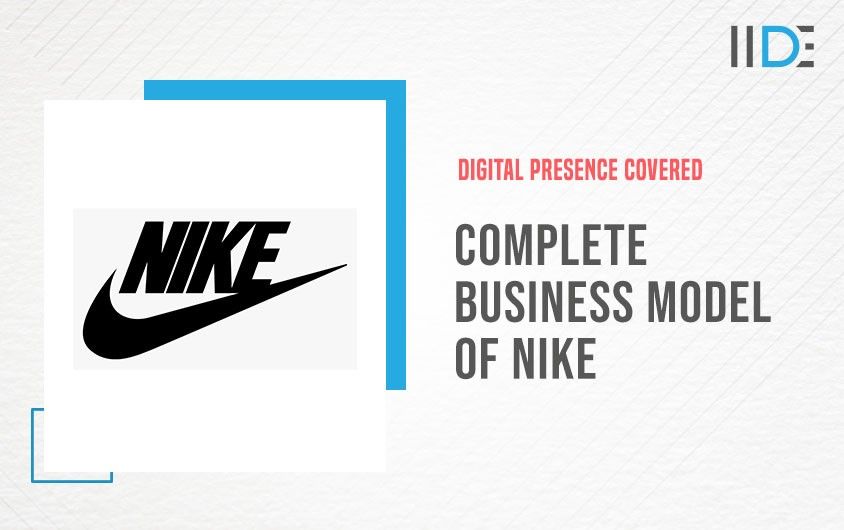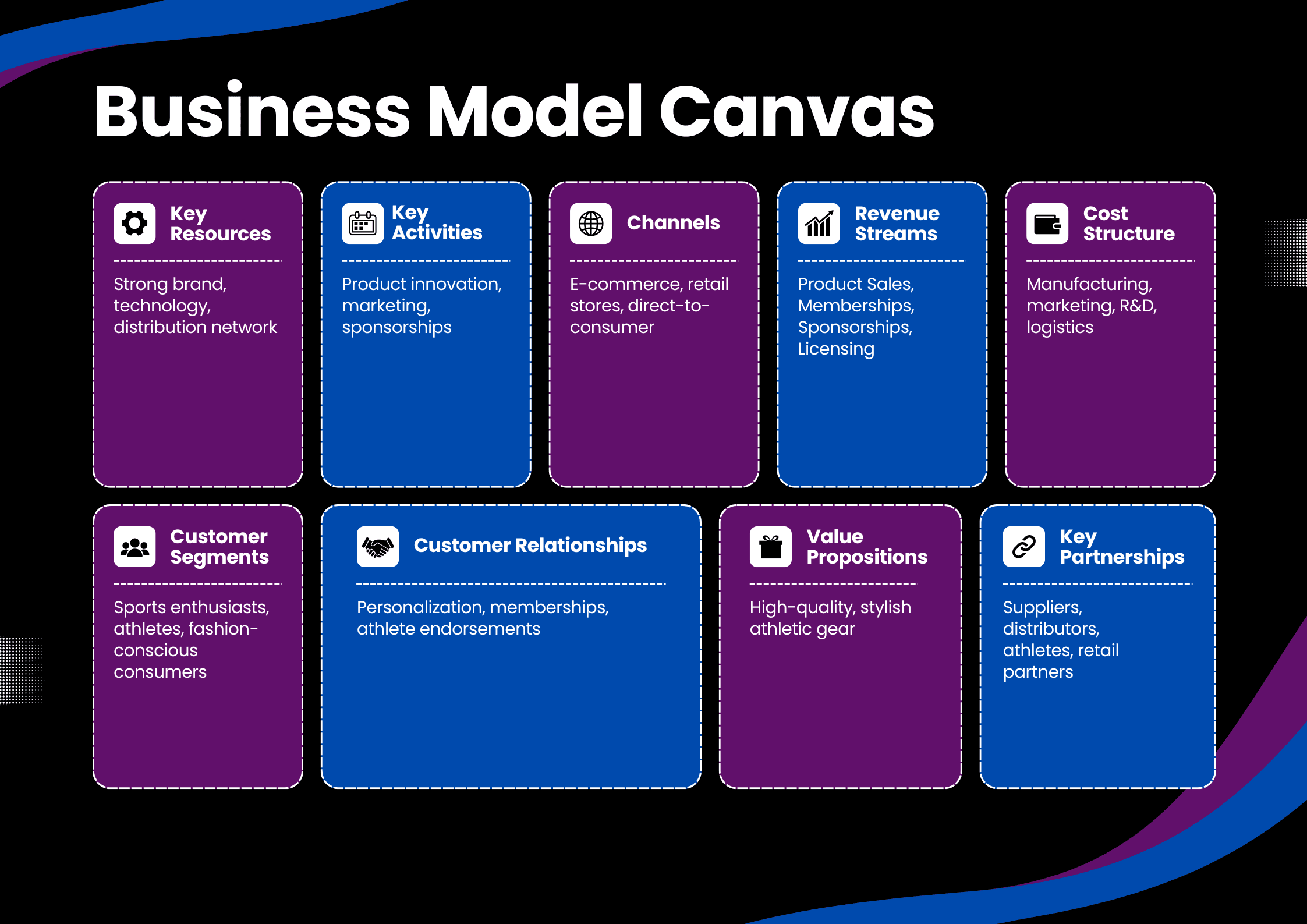Decode how AI is reshaping careers in 2026 with our Head of AI Programs in a LIVE online session. Register Now.

Updated on Dec 11, 2025
Share on:
Nike's business model is built on innovation, strong branding, and customer engagement. This strategy allows them to offer high-quality athletic gear while maintaining strong profit margins and market dominance. Nike achieves this by optimising its supply chain, leveraging global distribution networks, and focusing on cutting-edge technologies. The secret to its success lies in continuous product innovation and strategic marketing.
About Nike
Nike, founded in 1964 by Bill Bowerman and Phil Knight, is a leader in athletic apparel and footwear. The company revolutionised sportswear by combining innovation, style, and functionality. With annual revenue exceeding $50 billion in 2023 and operations in over 190 countries, Nike dominates the sportswear market. Its core philosophy centres around performance, innovation, and sustainability. Nike focuses heavily on customer experience, offering personalised products, leveraging digital technologies like Nike Training Club, and offering exclusive membership benefits. The brand is known for its iconic "Just Do It" slogan and its partnerships with top athletes and teams. Nike's secret to success is its ability to continuously innovate while fostering brand loyalty through effective marketing and global outreach.
| Feature | Details |
|---|---|
| Founded | 1964 |
| Founder | Bill Bowerman, Phil Knight |
| Headquarters | Beaverton, Oregon, USA |
| Industry | Sportswear & Footwear |
| Revenue (2023) | $50 billion |
| Presence | 190+ countries |
| Employees | 79,100 (2023) |
| Popular for | Athletic footwear, apparel, innovation |


Learn Digital Marketing for FREE


How does Nike make money?
1. Revenue Stream Breakdown:
- Product Sales: Nike generates the bulk of its revenue through direct sales of shoes, apparel, and equipment (70%)
- Nike Memberships & Subscriptions: Subscriptions, including services like Nike Training Club, contribute to 10% of revenue
- Licensing & Partnerships: Deals with retailers and athletes provide additional income
- Advertising Revenue: Nike also generates income from sponsorships and advertisements
2. Revenue Contribution:
Product Sales (70%), Memberships & Subscriptions (10%), Licensing & Partnerships (15%), Advertising Revenue (5%).
3. Pricing Strategy:
Nike uses a premium pricing model, which allows it to target high-income consumers and athletes while maintaining market positioning as a premium brand.
Nike’s marketing strategy has been pivotal in shaping its dominant position in the sportswear market through influential campaigns and sponsorships. Tap on the link to learn more.
Nike Business Model Canvas

Nike Value Proposition
Nike’s value proposition centres on delivering high-performance athletic products that combine style, innovation, and sustainability. Unlike other sportswear brands, Nike uses cutting-edge technology in product design, ensuring that athletes achieve peak performance while maintaining comfort.
The brand’s emotional appeal lies in empowering customers to reach their full potential, symbolised by its iconic "Just Do It" slogan. Functionally, Nike provides durable, long-lasting products that optimise performance, while also delivering value through personalised experiences like the Nike Training Club app.
Nike differentiates itself by offering exclusive access to limited-edition products and athlete-driven endorsements. Whether it's delivering the latest sneaker technology or sustainability-focused designs, Nike continuously adapts to consumer needs, positioning itself as a global leader in both product excellence and customer loyalty.
Nike Revenue Model
Nike primarily generates revenue from product sales, including footwear, apparel, and equipment, accounting for 70% of total income. Memberships and subscriptions (Nike Plus, Nike Training Club) contribute 10%, while licensing and partnerships generate an additional 15%. Finally, advertising and sponsorships contribute 5%. The brand maintains a strong online presence, with a growing portion of revenue derived from eCommerce channels, supplemented by physical retail stores.
Nike Cost Structure
Nike’s major expenses include logistics, manufacturing, marketing, and research and development (R&D). The company saves costs through automation, outsourcing manufacturing, and leveraging economies of scale. Nike invests heavily in brand promotion and digital innovation while keeping operating margins strong through efficient supply chain management and bulk production. Its cost-saving strategies help balance its premium pricing strategy.
Nike Customer Segment
Nike operates primarily in a B2C model, catering to young, active, and health-conscious individuals. The target demographics include 18-34-year-olds, both men and women, globally, with an income level from middle to high-income. Customers are often athletes, fitness enthusiasts, and fashion-forward individuals looking for performance and style. Nike also appeals to early adopters and millennials, who value innovation and sustainability in their products.
Distribution Channels of Nike
Nike uses an omnichannel strategy, integrating both physical retail stores and online platforms. Its eCommerce website, mobile app, and third-party platforms like Amazon drive its global reach. The brand's flagship stores and franchise networks bolster its presence in key markets. Nike also utilises direct-to-consumer sales channels and innovative tools like AR apps for customer engagement, making shopping more personalised and seamless.
Nike Key Partnerships
Nike collaborates with top athletes, sports teams, retailers, and technology partners to enhance its product innovation and market reach. Key suppliers, such as manufacturing partners in Asia, help produce its goods efficiently. Nike also has strong partnerships with NGOs and sustainability-focused organisations, which help reduce the brand’s environmental footprint. These collaborations strengthen Nike’s supply chain and sustainability initiatives while ensuring access to cutting-edge technologies and global distribution.
Interested in similar reads? Consider a SWOT analysis of Nike which will help to understand the company’s strengths, weaknesses, opportunities, and threats in the competitive sportswear industry.
SWOT Analysis of Nike
| Strengths | Weaknesses | Opportunities | Threats |
|---|---|---|---|
| Strong brand equity | High manufacturing costs | Expanding digital presence | Rising competition |
| Product innovation | Reliance on external suppliers | Global market expansion | Changing consumer preferences |
| Athlete endorsements | Vulnerability to counterfeits | Eco-friendly innovation | Economic downturns |
Key Takeaways for Students / Marketers
- Nike’s scalable business model relies heavily on strong branding and continuous product innovation
- Smaller businesses can replicate Nike’s customer-centric approach by focusing on personalised experiences and innovation
- Nike's mindset revolves around creating emotional connections with customers while maintaining premium product quality and leveraging data-driven insights
Conclusion
Nike’s business model thrives on its global presence, innovation, and ability to adapt to consumer demands. As the market evolves, Nike’s continuous focus on technology and sustainability positions it for future success, with an ability to adapt to emerging trends and maintain its market leadership.
Want to Know Why 2,50,000+ Students Trust Us?
Dive into the numbers that make us the #1 choice for career success

MBA - Level
Best For
Fresh Graduates
Mode of Learning
On Campus (Mumbai & Delhi)
Starts from
Jan 5, 2026
Duration
11 Months
Live & Online
Best For
Working Professionals
Mode of Learning
Online
Starts from
Dec 19, 2025
Duration
4-6 Months

Online
Best For
AI Enthusiasts
Mode of Learning
Online
Duration
5 Months

Offline
Best For
12th Passouts
Mode of Learning
On Campus (Mumbai)
Duration
3 Years
Recent Post
Nike’s main products include athletic footwear, apparel, and equipment for various sports and activities.
Nike’s top competitors include Adidas, Puma, Under Armour, New Balance, and Reebok.
Nike uses advanced materials, wearable tech, and digital platforms to enhance product performance and customer experience.
Nike holds approximately 27.4% of the global sportswear market.
Nike’s CSR initiatives focus on sustainability, community support, and diversity and inclusion through programmes like Move to Zero and the Nike Community Impact Fund.
Nike markets its products through inspirational storytelling, athlete endorsements, digital marketing, and social media engagement.
Aditya Shastri leads the Business Development segment at IIDE and is a seasoned Content Marketing expert. With over a decade of experience, Aditya has trained more than 20,000 students and professionals in digital marketing, collaborating with prestigious institutions and corporations such as Jet Airways, Godrej Professionals, Pfizer, Mahindra Group, Publicis Worldwide, and many others. His ability to simplify complex marketing concepts, combined with his engaging teaching style, has earned him widespread admiration from students and professionals alike.
Aditya has spearheaded IIDE’s B2B growth, forging partnerships with over 40 higher education institutions across India to upskill students in digital marketing and business skills. As a visiting faculty member at top institutions like IIT Bhilai, Mithibai College, Amity University, and SRCC, he continues to influence the next generation of marketers.
Apart from his marketing expertise, Aditya is also a spiritual speaker, often traveling internationally to share insights on spirituality. His unique blend of digital marketing proficiency and spiritual wisdom makes him a highly respected figure in both fields.
